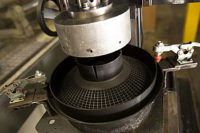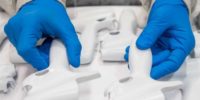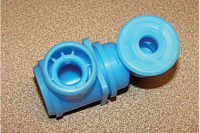
Automakers love vibration welding, as do their suppliers. For example, Mahle Filter Systems North America, a Tier I and II supplier of components for the automotive engine industry, has increasingly used vibration welding since the mid-1990s.
“Vibration welding produces a strong part, reduces cost and cycle times, and rarely causes a bottleneck in our assembly lines,” says Gary Henry, product engineer at Mahle Filter System’s plant in Murfreesboro, TN.
In January 1994, Mahle selected vibration welding to weld thermoplastic valve covers for Nissan. Later that year, Mahle began vibration welding carbon canisters. Vibration welding of turbo resonators began in 1999, followed by intake manifolds in 2006.
Annually, the company welds more than 3 million carbon canisters, 2 million valve covers, 1 million intake manifolds and 300,000 turbo resonators. Depending on production demands, Mahle operates from 30 to 35 welders at any one time. Cycle time for each product is about 20 seconds, with actual welding times ranging from three to eight seconds.
The company does not weld any dissimilar materials. Most of the parts Mahle welds are made of nylon 6 or nylon 6/6. Some parts are made of polypropylene. Henry says a large percentage of canisters are also assembled with ultrasonic welders. The company also spin welds some blow-molded parts and hot-plate welds some air-induction parts.
Intake manifolds measure 24 by 12 by 16 inches and are the largest parts Mahle vibration welds.
“Sometimes a small pipe must be welded into a manifold because the pipe couldn’t be molded in,” says Henry. “Vibration welding is great for that.”
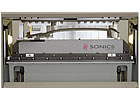
Besides welding thermoplastic parts, vibration welding can weld thermoplastic parts to fiber materials. This photo shows carpet being welded to plastic to form a map pocket on the inside of a car door. Photo courtesy Sonics & Materials Inc.
Whole Lot of Shakin'
“Imagine rubbing your top palm against the bottom one to generate heat,” says Scott Olson, inside sales manager for Forward Technology. “Vibration welding uses that same concept to melt and join two plastic parts.”A vibration welder consists of an electromagnetic drive system (linear or orbital), lift table, fixtures and controls. The drive system features a vibrator platen suspended by springs, and side electromagnetic heads that, when energized by electric current, cause the platen to vibrate. Most vibration welding applications involve linear platen movements, although a limited number call for orbital movements.
Lift table size will vary-from 24 by 18 inches in small welders, to 72 by 24 inches in large welders. Fixtures are custom made of aluminum, urethane or chrome-plated steel. Welder controls let operators change weld and hold time, joint pressure, frequency, amplitude and voltage.
Before welding can occur, the top and bottom thermoplastic parts are fixtured and mated on the lift table. This table is then raised hydraulically until the top part is snug inside the upper fixture attached to the vibrating platen.
Once the electromagnetic heads are energized, the top part within the platen vibrates laterally at a frequency from 100 to 250 hertz and moves back and forth across the bottom part a distance of 0.25 millimeter to 4 millimeters. This top-part vibration and movement, combined with pressure applied from the lift table, creates frictional heat at the joint interface of the two parts.
As vibration and movement continue, the heat increases and the thermoplastic parts’ polymer structures begin to melt. (The melt temperature varies depending on the thermoplastic; polypropylene, for example, requires 350 F, whereas nylon requires 400 F.)
The process known as weld penetration then occurs, as molten materials at the joint interface begin to flow together and bond. Weld penetration usually lasts from 0.5 second to 10 seconds.
“The melt temperatures must be within 40 F of each other or the parts won’t weld,” says Ray Laflamme, worldwide automotive marketing manager for Dukane Corp.
After sufficient weld penetration, the vibration is stopped, although penetration continues due to table pressure. The welding head then returns the vibration platen to a precise alignment for the next welding cycle.
A cool-down period of 0.5 second to 5 seconds is necessary for the welded part so it can withstand handling. After cooling, the table is lowered and the welded part removed.
A Fondness for Thermoplastic
Vibration welding is well-suited for most thermoplastics. Those that offer excellent welding characteristics include ABS, polycarbonate ABS, acetal, acrylic, cellulosics (synthetic plastics), nylon, polycarbonate, polyesters, polyphenylene, polypropylene and polystyrene. Vibration welding can also create good welds in parts made of butadiene-styrene, liquid crystal polymers, polyamides, polyethylene, polyphenylene sulfide and PVC.
“Nylon is great for vibration welding because, being hygroscopic, it can retain moisture and effect the long-term strength of the bond,” says Mark Caldwell, national sales manager for Sonics & Materials Inc. “The amount of plastic material that flows in the vibration joint prevents possible separation of the parts after welding.”
Welding similar thermoplastics is always recommended, although dissimilar thermoplastics can also be welded. In addition, vibration welding can be used to weld thermoplastic parts to fiber-filled materials.
For example, Caldwell says one customer vibration welds carpet material to thermoplastic door panels to form the map pocket often found at the bottom of interior front doors in minivans.
Suppliers can also vibration weld stacks of flat plates separately for later assembly. Kevin Buckley, technical applications manager for Branson Ultrasonics Corp., says one customer welds together seven layers of fabric used in an air bag chute. Each layer is 0.030-inch thick.
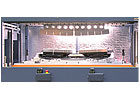
Tier I and II auto suppliers perform a lot of vibration welding. Here a large rear spoiler for a small SUV is about to be vibration welded. The spoiler is in the lower fixture upside down. Photo courtesy Dukane Corp.
Beyond Large Parts
Besides welding large parts, vibration welding also:Welds many joint designs. These include various types of tongue-and-groove, butt and rib joints.
Welds parts of various shapes. Such parts can be vibration welded so long as the surfaces to be welded are within 15 degrees of the horizontal plane.
Welds multiple small parts. Users who need to weld small parts can fill the fixtures with several mated parts and weld them simultaneously.
Allows quick changeover. Welding machine operators can change fixtures within minutes, improving throughput rates.
Provides permanence. Welded parts are permanently joined and will be damaged if reopened. Weld permanence prevents stress relaxation, creep or cold flow in the joint area.
Requires no additional materials. Vibration welding requires no adhesives, solvents, inserts or fasteners, helping to lower cost per weld.
Entraps other parts. Additional parts can be placed between the two parts to be welded so long as the parts do not interfere with the welding process.
Operates energy efficiently. Vibration welding allows for on-demand energy usage and generates no excess heat that needs to be removed from the work area.
Creates aesthetically pleasing joints. Sometimes vibration welding can generate particulates and create welds that are not aesthetically pleasing. To prevent this, Branson has developed CVT (clean vibration technology), which preheats the weld joint with infrared energy so less vibration and force are necessary. Metal foil emitters emit the infrared energy at wavelengths optimal for absorption by typical thermoplastic resins.
Buckley says CVT is used to weld automobile tail lamps made of ABS and or polycarbonate blends that cannot be joined cleanly with conventional vibration welding. He says the technology is currently being used in production in all geographic regions and will become more common as lamp manufacturers move to more-stringent aesthetic requirements.
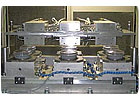
In this application, clean vibration technology (CVT) creates aesthetically pleasing welds on six automotive fog lamps simultaneously. CVT involves preheating the joint with infrared radiation so less vibration and force are necessary, resulting in no particulates. Photo courtesy Branson Ultrasonics Corp.
Drawbacks
Equipment cost is the main drawback of vibration welding. Although vibration welders can provide 20 or more years of service, they are expensive. A standard or modified machine usually costs about $100,000. The custom fixtures used in the machine cost, on average, from $10,000 to $35,000.Other drawbacks include:
Noise. Because they operate at very high frequencies, vibration welders generate noise that exceeds 90 decibels. To limit noise, suppliers fully enclose their welders.
Space limitations. Part size is limited by the available table space in the welder.
Assembly line limitations. Because welding machines are fully enclosed, parts cannot be easily positioned and removed with a conveyor or indexing table. This might limit the ability to integrate vibration welders into automated assembly systems.

Lift table size will vary-from 24 by 18 inches in small welders, to 72 by 24 inches in large welders. The lift table shown is 48 by 22 inches, with a mounted fixture that is much smaller. Photo courtesy Forward Technology
Tips for Optimum Welding
What can OEMs and their suppliers do to ensure their vibration welders create the best welds possible? Here are some suggestions.First, keep the lower part rigid so its walls don’t flex. As a general rule, the larger the part, the more tendency there is for wall movement. It might be necessary to add ribs or gussets to the part design to prevent flexing.
Second, always use fixtures as intended. Fixtures are custom designed to hold a specific part or parts and should never be used to hold other parts. Equally important, end-users should never build their own fixtures to save money. Doing this increases the likelihood of poor welds.
Third, verify proper frequency of the vibrator platen each time the top-part fixture is changed. Welding at the wrong frequency can damage or even break the welder’s drive system.
Rather than rely on manual tuning of the upper tool (fixture), the MX Series welder from Sonics & Materials Inc. uses an Auto-Tune feature to automatically detect, set and lock-in the platen’s optimum frequency within seconds. This feature helps vibrate the platen at maximum efficiency with minimal power.
Finally, and most importantly, bring the vibration-welder supplier into the product design and welder-selection process as early as possible. Application specs and other key data from the end-user are essential if the supplier is to make a welder and part-holding fixtures that meet the customer’s exact needs and expectations.
“By working together early, the supplier and end-user can come up with the proper joint design, optimal welding process and most efficient cycle time,” says Olson.
End-users also need to be patient. Laflamme says they should allow 3 to 5 months from the time they first meet with a supplier until their welder is up and running smoothly.

